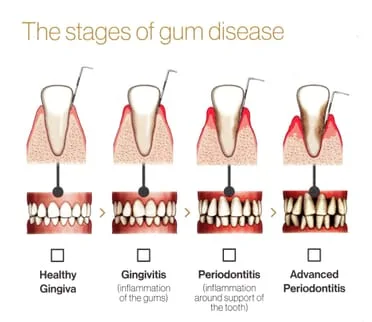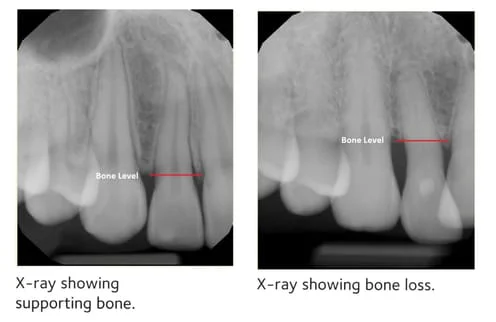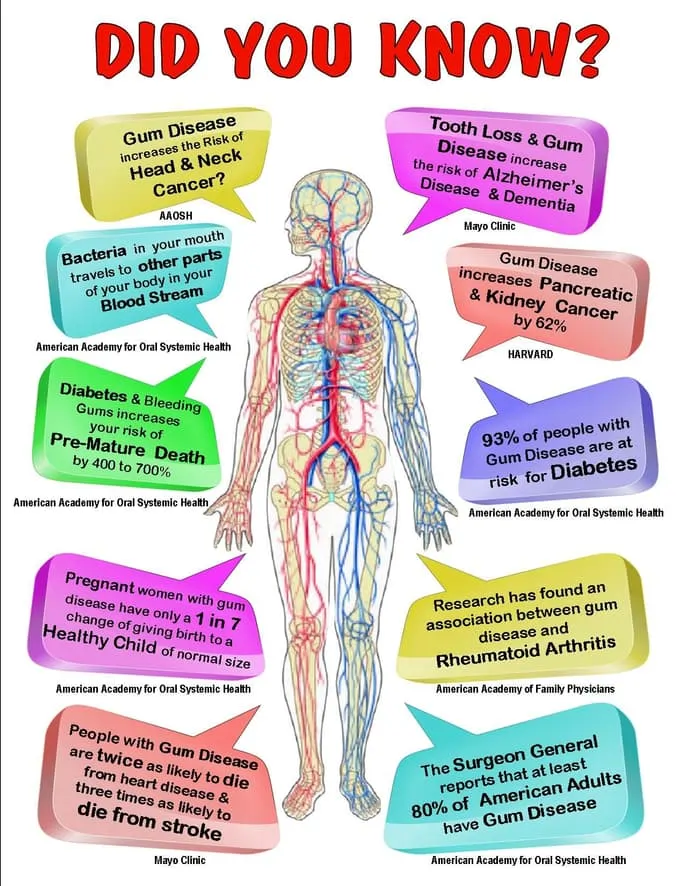Don't Wait Until It Hurts!
Periodontal disease is an infection that affects the tissues and bone that support your teeth. It is also called gum disease. When your gums are healthy, your gum tissues tightly hug each of your teeth. When you have gum disease, your gums pull away from your teeth and may become red, puffy and swollen. As the gum disease gets worse, the tissues and bones that support your teeth can become damaged. Over time, your teeth may need to be removed. Treating gum disease in the early stages is very important and can help prevent tooth loss.
Warning Signs of Periodontal Disease - you may notice one or some of these warning signs, or you may not have any signs of gum disease at all. This is why it's important to see your dentist regularly - treatment of gum disease is most successful when it's caught early.
- Gums that bleed when you brush or floss
- Gums that are red, swollen, puffy or tender
- Gums that no longer tightly hug your teeth
- Bad breath or a bad taste in your mouth that doesn't go away
- Increasing spaces between your teeth
- Feeling that your teeth are loose
- A change in the way your teeth fit together when you bite
- A change in the way your partial dentures fit
What Causes Periodontal Disease?
Plaque is a sticky film that is always on your teeth. Bacteria that live in the plaque can make your gums red, puffy and swollen. When plaque is left on your teeth and gums, it can harden. Hardened plaque is also called tartar or calculus. Tartar on your teeth makes it hard for you to keep your teeth and gums clean on your own.
Gums that are red, puffy and swollen also may start to pull away from your teeth. Spaces called pockets start to form between your gums and teeth. These pockets give bacteria a place to collect and grow. The bacteria in your pockets will cause your gum disease to get worse.
Stages of Periodontal Disease
- Healthy Gums - your teeth are held in place by gums, bone and connective tissues (like ligaments). Your gums hug your teeth tightly and there is little or no buildup of plaque and tartar on them.
- Gingivitis - the bacteria in plaque make your gums red, tender and swollen. Your gums might bleed at this stage. You can also have gingivitis and not have any signs of it. Gum disease at this stage is usually reversible with a professional cleaning by a dental hygienist followed up with your own good daily home care by brushing and cleaning between your teeth.
- Periodontitis - in time, as plaque and tartar build up where your teeth and gums meet, the gum tissues and bone around your teeth begin to break down. Periodontitis affects about 42% of adults over age 30 in the United States.
- Advanced Periodontitis - your teeth become loose and may need to be removed by a dentist. This stage is very serious and may require surgical treatment.
Checking for Periodontal Disease
When checking for periodontal disease, your dental hygienist uses an instrument called a periodontal probe to gently measure the depth of the pockets around each of your teeth. When your teeth are healthy, the pocket depth should be 3 millimeters (mm) or less. Usually, the more severe the disease, the deeper the pocket. This means more advanced loss of bone attachment, allowing the bacteria to have more room to grow and cause serious damage to your gums and bone, loosening your teeth.
Dental x-rays can check for the amount of bone supporting your teeth. If low bone levels are spotted, it could be a sign of damage from gum disease.
Am I At Risk?
Anyone can get periodontal disease. There are a few factors that can increase your risk of getting periodontal disease.
- Not taking care of your teeth and gums - Be sure you brush 2 times a day, every day, and for 2 minutes each time.
- Using tobacco of any kind - you are more likely to have gum disease if you smoke, chew or dip tobacco
- Many medications - such as steroids and blood pressure drugs, can affect your gums
- Pregnancy - use of birth control pills or changes in female hormone levels. These can increase your risk of gingivitis and may cause your gums to swell and bleed
- Family History - if you have a family history of tooth loss, be aware and pay close attention to changes in your gums
Gum Disease and Whole Body Health
Gum disease may also be seen more often in people with diabetes or those with some forms of heart disease. It's important to talk to your dentist about medications you may be taking or health problems you may have. Together, you can work out an oral care plan for your best oral health.
Treating Periodontal Disease
Professional Cleaning - if the gum disease is caught early enough (while it is still gingivitis), you may simply need a professional cleaning and improved home hygiene. Your dental team can also give you advice for improving your daily oral hygiene.
Scaling and Root Planing (click for more detailed info) - a professional cleaning is not enough if your gum disease is severe. Usually a special deep cleaning called scaling and root planing is needed. This involves your hygienist carefully removing plaque and tartar down to the bottom of each periodontal pocket, then smoothing the tooth's root surfaces to help your gums heal and reattach to the tooth, shrinking the pocket depth. This will involve more frequent follow-up visits to reduce plaque and tartar and maintain tighter pockets.
Your dentist may also refer you to a periodontist - a dentist who specializes in the treatment of gum disease. A periodontist is well versed in the surgical treatment of gum disease.
- Periodontal Surgery - if the pockets do not heal enough after scaling and root planing, periodontal surgery may be needed. Surgery allows your periodontist to remove tartar and plaque from hard-to-reach areas. After surgery, your gums are stitched into place to tightly hug your teeth. Surgery can reduce pocket depth and make it easier to keep your teeth clean.
Keeping Gums Healthy After Treatment (Post-Scaling & Root Planing Instructions)
- Your hygienist will suggest more frequent cleanings to keep your gums disease under control
- Keep plaque under control by brushing 2 times daily with a fluoride toothpaste for 2 minutes each time. Clean between your teeth daily using floss or another between-the-teeth cleaner
- Your dentist may suggest or prescribe medicines to help control infection and pain or to help your gums heal
- If you use tobacco in any form, ask your dentist or physician for information on how to quit (click here)
- If you have a disease that may be linked to gum disease, such as diabetes, work with your physician to help manage it
(C) American Dental Association



